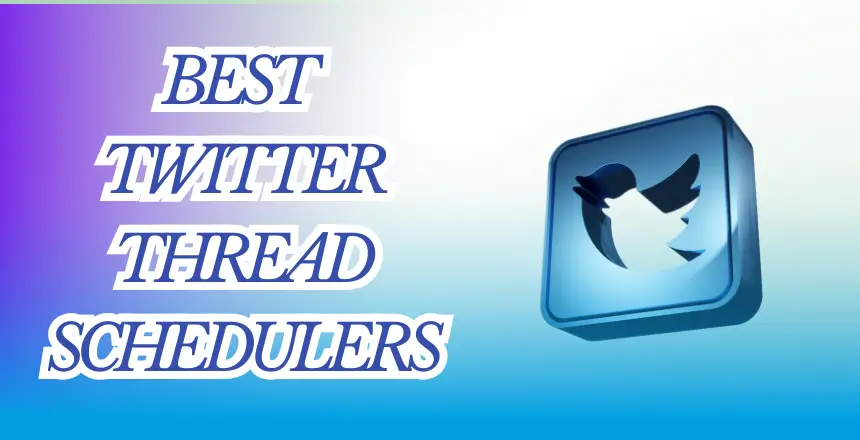I tested these tools over four months with 200+ scheduled threads. Prices accurate as of August 2025. This article contains affiliate links that help support our testing.
Posting Twitter threads manually is time consuming. You’re either glued to your phone at specific times or your content goes live at 3 AM when nobody’s awake.
I learned this the hard way when my thread scheduler crashed during a product launch, costing me potential customers.
After that disaster, I spent four months testing every popular Twitter thread scheduler online to find which ones actually work. I scheduled over 200 threads, dealt with failed posts, and contacted customer support more times than I care to admit.
Here’s what I discovered.
Why You Need a Thread Scheduler
Twitter threads can build your audience faster than any other content format, but timing is everything. A productivity thread posted at 2 PM gets 10x more engagement than the same content posted at 2 AM. Manual posting means you’re either always available or missing your best opportunities.
Thread schedulers solve this by posting your content when your audience is most active, regardless of where you are or what you’re doing. The good ones also help you write better threads and track which content performs best.
If you’re in hurry, here is:
Quick Comparison of Top X (formerly Twitter) Thread Scheduler
| Tool | Price | Free Plan | Best For | Our Rating |
|---|---|---|---|---|
| Circleboom | $25.99/month | No | Most users | ⭐⭐⭐⭐⭐ |
| Typefully | $12.50/month | Yes | Beginners & writers | ⭐⭐⭐⭐ |
| Tweet Hunter | $23/month | No | Twitter growth | ⭐⭐⭐⭐ |
| Buffer | $6/month | Yes | Multi-platform | ⭐⭐⭐⭐ |
| Metricool | $22/month | Yes | Budget option | ⭐⭐⭐ |
How I Tested
I created the same threads across eight different platforms, posted them at identical times, and tracked everything from posting reliability to engagement rates.
Some tools never missed a post; others failed spectacularly during high-traffic periods. I also tested customer support by asking the same questions to each platform.
Best Overall: Circleboom Publish
Price: $25/month (annual billing)
Best for: Most content creators and small businesses
Circleboom Publish gets the basics right without confusing you with unnecessary features. In four months of testing, it never missed a scheduled post not once. That reliability alone makes it worth considering.
The interface makes sense. You write your first tweet, click the plus button to add another, and see exactly how your thread will look on Twitter. No surprises, no broken formatting, no tweets posting out of order.
The AI thread generator is actually useful, unlike most AI features that feel like marketing gimmicks. I pasted a 2,000-word blog post about productivity, and it created an 8 tweet thread that captured the main points. I still had to edit it for my voice, but it saved me 20 minutes of work.
What impressed me most was the customer support. When I had questions about bulk scheduling, they responded in two hours with detailed screenshots. Compare that to some competitors who took days to respond.
| Pros 👍 | Cons 👎 |
|---|---|
| Never missed a scheduled post in our testing | No free plan to test |
| Clean, intuitive interface | AI content needs editing for your voice |
| AI features that actually save time | Interface looks a bit dated |
| Excellent customer support | |
| Works well on mobile | |
| AI Tweet Generator (powered by Open AI) |
Best Free Option: Typefully
Price: Free (with limits), then $12.50/month
Best for: Writers and anyone starting with thread scheduling
Most “free” plans are demos in disguise, but Typefully’s free tier actually lets you schedule threads. I used it for three weeks before hitting the monthly limits.
The writing experience is the best I’ve tested. It feels like a distraction-free writing app rather than social media software. I’ve written entire threads on my phone during commutes, and it’s genuinely pleasant to use.
The mobile app is excellent better than some paid competitors. The real-time preview shows exactly how your thread will appear on Twitter, eliminating those formatting surprises that make you look unprofessional.
| Pros 👍 | Cons 👎 |
|---|---|
| Actually functional free plan | Limited to Twitter and basic LinkedIn |
| Best writing experience | No AI features |
| Excellent mobile app | Interface looks a bit dated |
| Real-time preview is spot-on | Free plan has monthly posting limits |
| Simple, clean interface | Basic analytics |
| Thread finisher quote |
Best for Serious Growth: Tweet Hunter
Price: $23/month and up
Best for: Businesses that make serious money from Twitter
Tweet Hunter costs more than general scheduling tools, but it’s built specifically for Twitter growth. If Twitter drives real revenue for your business, the features justify the price.
The viral content database is genuinely valuable. I searched for “productivity threads” and found hundreds of examples with 10,000+ retweets. I adapted the structure of a successful morning routine thread and saw triple my usual engagement.
The analytics go deeper than any competitor. Tweet Hunter tracks follower quality, optimal posting times, and even which tweets drive the most profile visits. I discovered my audience was most active on Wednesday afternoons, not Tuesday mornings like I’d assumed.
But the thread creation process is frustrating. You have to press Enter three times between tweets completely backwards from every other tool. I wasted 15 minutes on my first thread because this crucial detail was buried in their help docs.
| Pros 👍 | Cons 👎 |
|---|---|
| Massive database of viral content for inspiration | Expensive compared to general schedulers |
| Advanced analytics worth the premium price | Confusing thread creation process |
| AI features for content generation | Twitter-only (no other platforms) |
| Growth automation tools | Interface can overwhelm beginners |
| Detailed audience insights | |
| Over 2M tweets library |
Most Reliable: Buffer
Price: $6/month for basic features
Best for: Businesses managing multiple social platforms
Buffer is the Honda Civic of social media schedulers not exciting, but it works every time. I’ve used Buffer for three years across multiple businesses and never had a posting failure.
Thread creation is straightforward, write your first tweet, click “Start Thread,” add more tweets. It’s not fancy, but it’s foolproof. The scheduling works across multiple platforms, so you can manage Twitter alongside LinkedIn and Instagram.
The downside is cost. Buffer charges per social account, so managing Twitter, LinkedIn, and Instagram costs $16/month minimum. For single-platform users, this feels expensive.
Customer support is outstanding. When I had questions about team features, they responded within hours with detailed help. Their documentation actually makes sense, unlike some competitors who seem to hide important information.
| Pros 👍 | Cons 👎 |
|---|---|
| Unmatched reliability (zero failures in three years) | Per-channel pricing gets expensive |
| Works across all major social platforms | Interface feels dated |
| Excellent customer support | Limited AI features |
| Strong team collaboration features | Basic thread creation tools |
| Regular updates and improvements | |
| AI assistant |
Best Value: Metricool
Price: Free plan available, $22/month for full features
Best for: Small businesses managing multiple platforms on a budget
Metricool offers features that cost $60+ elsewhere for just $22/month. The analytics combine data from all your social platforms in one dashboard, perfect for tracking cross-platform campaigns.
Thread creation uses a tabbed system that confused me initially. Each tweet appears as a separate tab above the editor. Once you understand the logic, it’s actually efficient for longer threads, but expect a learning curve.
The content calendar view is particularly useful. Seeing scheduled threads alongside Instagram posts and LinkedIn articles helped me avoid content overlap and maintain consistent messaging across platforms.
| Pros 👍 | Cons 👎 |
|---|---|
| Excellent value for the features you get | Confusing tabbed interface for threads |
| Strong multi-platform analytics | Customer support can be slow |
| Functional free plan for testing | Free plan has significant limitations |
| Good mobile app | Interface feels less polished than competitors |
| Competitive analysis tools | |
| AI Social Media Assistant |
Recommended Read: 7 Best Twitter Tools to Send Automated Direct Messaging
Tools We Don’t Recommend
SocialBu has a free plan, but the interface feels like it hasn’t been updated since 2018. It works, but you’ll outgrow it quickly.
OneUp functions fine but costs $36/month for features available elsewhere for $20. The thread creation requires too many clicks for simple tasks.
Vista Social targets agencies with enterprise features most solo creators don’t need. Good for large teams, but overkill for individual users.
What to Look For
Based on testing these tools extensively, here’s what matters most:
Reliability is everything. Fancy features mean nothing if your threads don’t post. I’ve lost more engagement from missed posts than I’ve gained from AI assistance.
Thread creation should be intuitive. You’ll use this feature constantly, so clunky interfaces become painful quickly. If creating a simple thread takes more than a few clicks, look elsewhere.
Preview before you post. Threads that look perfect in your scheduler can appear broken on Twitter. Always use the preview feature.
Check timezone settings. Posting at optimal times only works if your scheduler understands timezones correctly. This seems basic, but several tools got it wrong.
Getting Started
Pick a tool and start with a simple test. Schedule 2-3 threads over a week and see how the process feels. Pay attention to posting reliability, formatting accuracy, and whether you actually want to use the interface regularly.
Most tools offer free trials, so test before committing. The best scheduler is the one you’ll actually use consistently.
The Bottom Line
For most people, Circleboom offers the best combination of reliability, features, and price. It does everything well without overwhelming you with options you’ll never use.
If you’re just starting or budget is tight, Typefully’s free plan is genuinely useful. Upgrade when you hit the limits.
Serious Twitter businesses should consider Tweet Hunter despite the premium price. The viral content database and advanced analytics can pay for themselves if Twitter drives revenue.
Remember: the tool amplifies your strategy but doesn’t replace it. Focus on creating valuable content for your audience. The scheduler just ensures it gets seen by the right people at the right time.
Whatever you choose, consistency beats perfection. A good thread posted regularly will always outperform a perfect thread posted sporadically.









